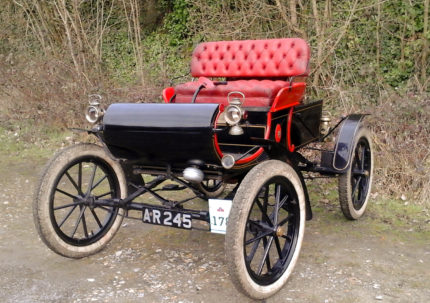A 1903 Oldsmobile runabout, still running after 115 years, is going under the hammer at the H&H Classics Auction on October 17th. The pre-sale estimate is £34,000 to £37,000 ($44,361 – $48,275), double the car’s original sticker price adjusted for inflation.
Made by the Olds Motor Works, in Lansing, Michigan, it was exported to Australia soon after it was first purchased. The runabout went walkabout for six decades before making its way to England. Since the 1960s, it has been a regular in the London to Brighton Veteran Car Run, a fitting participant for a run that was founded in 1896 to celebrate the passage of the Locomotives on the Highway Act which raised the speed limit for “light locomotives” from four miles per hour to 14 and abolished the requirement that all cars be preceded by a pedestrian waving a red flag.
Previous Locomotive Acts, The 1896 act untied those chains and basically made driving cars on the roads possible. The draconian regulations that discouraged motoring were replaced with a more reasonable regulatory framework to ensure safety of pedestrians and other vehicles — the 14 mph speed limit, front lights to make the car visible at night, a bell to make its presence heard night or day, restricted access to bridges as determined necessary by local authorities, etc.
Mr. Hugh Luttrell of Tavistock proposed the new speed limit on the grounds that:
Unless there were some limit these carriages might travel at a speed dangerous to the public. For they would only come under the provisions against furious driving – and this law – was extremely difficult to carry out. Policemen were now largely influenced in their idea of furious driving by the amount of exertion a horse was making. It would be quite possible to drive a rapid horse at ten or twelve miles an hour without being had up for furious driving, while to whip a slow horse into ten miles an hour would very likely appear as furious driving. These carriages would go as smoothly at one rate as at another, and it would therefore be extremely difficult to say what was furious driving. For these reasons he contended for a limit of speed, and he thought 14 miles an hour a reasonable maximum.
Makes sense to me. You can tell easily if someone is attempting to whip a horse into a frenzy. Accelerating a car even to the danger point is much harder thing to detect. All of the notes from the parliamentary debate over the Locomotives on the Highway Act are a fascinating glimpse into the transition from animal-powered road transportation and steam-powered rail transportation to motorized road vehicles.
Automobiles were still in their infancy as modes of conveyance seven years later, a fancy for the rich rather than a practical means of transport (an issue raised in the parliamentary debate over the matter of how much tax to charge per vehicle). The average yearly income in the United States was $489 in 1903. The Oldsmobile runabout cost $650. So even though it was the bestselling car in the US between 1902 and 1905 with 4,000 sold in 1903, its 4.5 horsepower couldn’t come close to comparing to the popularity of the literal kind. In 1903, 900,000 horse-drawn vehicles were sold.
